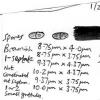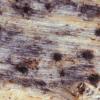
13-02-2013 12:26
Peter ThompsonHello Everyone,I have fruit bodies of a spherical

12-02-2013 16:44
Nina FilippovaI saw very beautiful blue coloring of VBs at tips

05-02-2013 01:09
Iglesias PlácidoHola, agradeceria información si tiene alguien so

12-02-2013 19:27
 Joop van der Lee
Joop van der Lee
Fruitbody does not look like that of an ascobolus

12-02-2013 15:52
Peter ThompsonHello to Everyone,I recently collected a sample co

11-02-2013 10:21
 Alessio Pierotti
Alessio Pierotti
can anyone help me for this article?ORTEGA A. &

12-02-2013 11:36
 Alessio Pierotti
Alessio Pierotti
I take this opportunity to thank all the friends t
Ascomycete with Dark, Tapering Hairs
Peter Thompson,
13-02-2013 12:26
I have fruit bodies of a spherical ascomycete resting on decorticated wood. They have tapering hairs with bulbous bases and macroscopically resemble Lasiosphaeria and related genera. (See attached photograph).
Microscopically, there are about 20 pale brownish 1-septate spores, which have remained inside each of the two perithecia which I have examined. (See attached sketch). I have not seen any asci.
My feeling is that it is a mature ascomycete, but quite old. If so, it has probably also been exposed to freezing temperatures and snow.
I wonder if anyone is aware of a species which possesses a combination of these spore and hair characteristics. My literature search has been unsuccessful.
Thank you,
Best wishes,
Peter.
Alain GARDIENNET,
13-02-2013 12:29
Re : Ascomycete with Dark, Tapering Hairs
It could be closed to Helminthosphaeria genus.
Did you observe asci and hamathecium ?
Sorry, I read the answer in your first mail. So it would be more difficult to have an opinion.
Alain
Did you observe asci and hamathecium ?
Sorry, I read the answer in your first mail. So it would be more difficult to have an opinion.
Alain
Peter Thompson,
13-02-2013 15:16
Re : Ascomycete with Dark, Tapering Hairs
Hello Alain,
Thank you for your reply.
I did not observe any asci - I think that the fruit bodies were probably too old. Only a few loose spores had been retained in the perithecia which I analysed.
I did not mention earlier that each fruit body seems to be seated on a brown, thick walled, septate hyphal subiculum about 2.5 to 3um wide. This subiculum is only located directly under each fruit body, rather than extending across the substrate.
I don't know whether this helps.
Best wishes,
Peter.
Thank you for your reply.
I did not observe any asci - I think that the fruit bodies were probably too old. Only a few loose spores had been retained in the perithecia which I analysed.
I did not mention earlier that each fruit body seems to be seated on a brown, thick walled, septate hyphal subiculum about 2.5 to 3um wide. This subiculum is only located directly under each fruit body, rather than extending across the substrate.
I don't know whether this helps.
Best wishes,
Peter.

